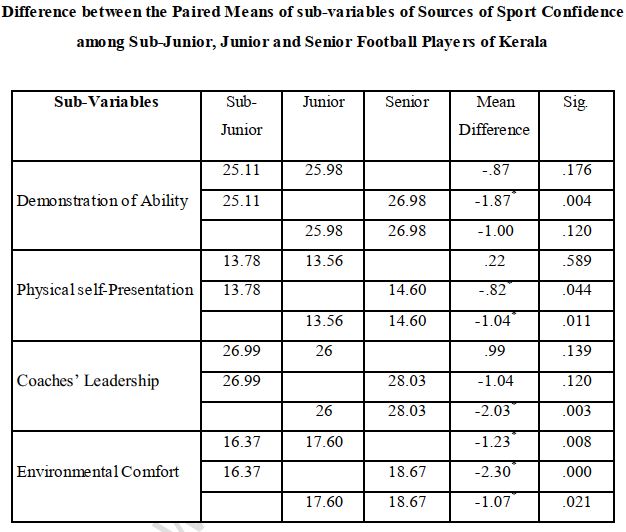ANALYSIS OF SOURCES OF SPORT CONFIDENCE AMONG KERALA FOOTBALL PLAYERS
Abstract
The purpose of this study was to analyze the sources of sports confidence among football players of Kerala state. The participants were 300 Football players (sub junior-100, junior-100 and senior-100), age group ranging from 12-30 from different districts of Kerala. Each participant completed the Sources of Sport Confidence Questionnaire (SSCQ) of Vealey, Hayashi, Holman and Giacobbi (1998), which assessed the performance/mastery, demonstration of ability, physical/mental preparation, physical self - presentation, social support, coach’s leadership, vicarious experience, environmental comfort, and situational favorableness. The data was analyzed using ANOVA. The findings of sub variables of Sources of Sport Confidence reveals that in demonstration of ability there was significant difference between subjunior and senior players; and no significant difference between sub-junior and junior and junior and senior players. In physical self-presentation there was significant difference between sub-junior and senior, and junior and senior; and no significant difference between sub-junior and junior. In coaches leadership there was significant difference between junior and senior and no significant difference between sub-junior and junior and sub-junior and senior. In environmental comfort there was significant difference between sub-junior and junior; sub-junior and senior; and junior and senior. There was no significant difference between sub-junior, junior and senior football players in performance/mastery, physical/mental preparation, social support, vicarious experience, and situational favorableness.
Downloads
References
Demaine, Cara; Short, Sandra E. (2007). Sources of sport confidence and their relationship with sport confidence in college basketball players. Journal of Sport & Exercise Psychology. Vol. 29, pS157.
Dongfang, C., Steve, C., Chou,H., and Chi, L. (2008). Gender Differential in the Goal Setting, Motivation, Perceived Ability, and Confidence Sources of Basketball Players.The Sport Journal.Vol.11,4.
Hays, K., Thomas, O., Maynard, I., Bawden, M. (2009). The role of confidence in worldclass sport performance. Journal of Sport Sciences, 27 (11), 1185-1199.
Nicholls, J. G. (1978). The development of the concepts of effort and ability, perception of academic attainment, and the understanding that difficult tasks require more ability. Child Development, 49, 800-814.
Vealey, R.S., Hayashi, S.M., Garner-Holman,G., & Giacobbi, P. (1998). Sources of sportconfidence in athletes: Preliminary conceptual and psychometric development. Journal of Sport and Exercise Psychology, 20, 54-80.
Weinberg, R., Gould, D., & Jackson, A. (1979). Expectations and performance: An empirical test of Bandura’s self-efficacy theory. Journal of Sport Psychology, 1, 320-331.
Weiner, B. (1980). Human Motivation. New York: Holt.















